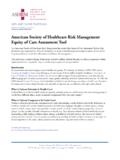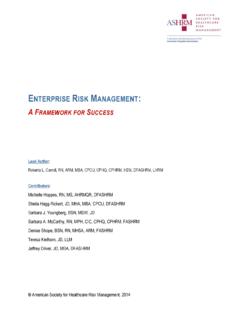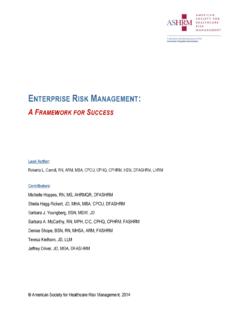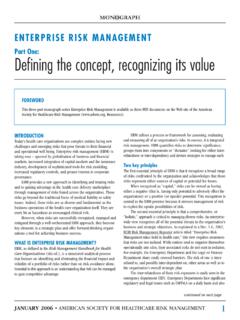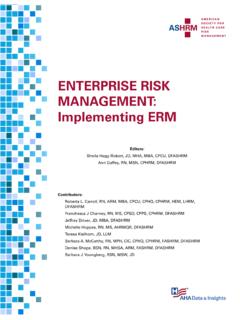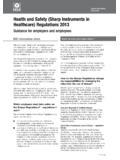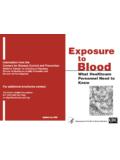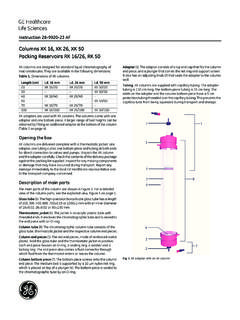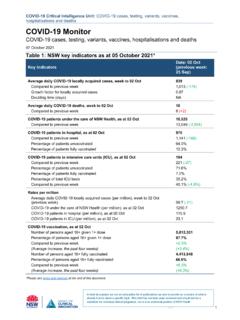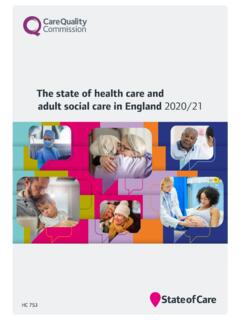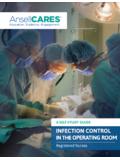Transcription of Serious Safety Events - American Society for Healthcare ...
1 White Paper Series Serious Safety Events : A Focus on Harm Classification: Deviation in Care as Link Getting to Zero White Paper Series Edition No. 2 Authors: Michelle Hoppes, RN, MS, DFASHRM: CEO at Michigan Professional Insurance Exchange-MPIE Jacque Mitchell, RN, BSN, CPHRM, FASHRM: Risk Manager at Sentara Healthcare Contributors: Stephen Pavkovic, RN, JD:, Director Patient Safety at University Health System Consortium Ellen Grady Venditti, RN, MS, CPHRM, FASHRM, Healthcare Risk Manager and Patient Safety Consultant Faye Sheppard, RN, MSN, JD, CPHRM, CPPS: former ASHRM board member Mary Ann Hilliard, BSN, JD: Chief Risk Counsel, VP Safety and Patient Experience at Children s National Medical Center Reviewed by: William B.
2 Munier, MD: Director, Patient Safety Organization Program Center for Quality Improvement and Patient Safety Agency for Healthcare Research and Quality 2 ASHRM White Paper Series: Serious Safety Events : Getting to Zero ASHRM | 155 N. Wacker Drive, Suite 400 | Chicago, IL 60606 Phone: (312) 422-3980 | Fax: (312) 422-4580 | E-mail: TABLE OF CONTENTS Pages FOREWORD .. 2 INTRODUCTION .. 3 HARM DEFINTIONS/DESCRIPTORS .. 3 HARM STUDIES AND PERCENTAGES .. 4 CLASSIFYING PREVENTABLE HARM: DEVIATION AS THE LINK .. 6 DEVIATION DETERMINATION GUIDE .. 8 KNOWN COMPLICATIONS AS PREVENTABLE HARM .. 10 Healthcare ASSOCIATED PREVENTABLE HARM LEVEL CLASSIFICATION TOOL.
3 10 CONCLUSION .. 14 REFERENCES .. 15 2014 American Society for Healthcare Risk Management ASHRM White Paper Series: Serious Safety Events : Getting to Zero 3 ASHRM | 155 N. Wacker Drive, Suite 400 | Chicago, IL 60606 Phone: (312) 422-3980 | Fax: (312) 422-4580 | E-mail: Forward Eliminating preventable harm is an American Society for Healthcare Risk Management (ASHRM) top priority. Surely, goal achievement is contingent upon many critical factors. While some factors are obvious such as excellent clinical care and conformance to evidence-based practice this paper focuses on less-obvious, but equally-influential, factors.
4 Understanding what is preventable at the time of harm occurrence Defining/describing harm in terms of a classification system Identifying and understanding contributing factors when harm occurs Describing how measurement drives improvement and aids in determining effectiveness of risk management Outlining how deviation in care is at the core of determining what is, or isn t, preventable In order to truly understand preventable harm, it is important to measure patient Safety and to establish whether or not current and potential Safety solutions are effective. Clearly, preventable harm measurement is a challenge because defini- tions of harm vary among different data-capture methods.
5 Similarly, disparate classification systems make it difficult to clarify and mitigate underlying causes of harm. These challenges affect our ability to determine and demonstrate effec- tiveness of patient Safety and risk management interventions that reduce errors and preventable harm1. Measures drive improvement, inform consumers and influence payment. Private and public payers use measures to make judgments about the providers with which they contract and to incentivize improvements in care. This is another reason why defining, classifying, and focusing action on prevention of harm should be a central component of any proac- tive risk management program.
6 In the first installment of ASHRM s Serious Safety Events (SSEs) Getting to ZeroTM white paper series, we focused on event investigation process steps. One component of the investigation process is to determine a harm score, which often triggers risk management and organizational response. Without a reliable and accurate harm-score assignment, opportu- nities for implementing an effective response may be lacking. 1, 2 Defining Harm Before a preventable harm classification system can be outlined for Serious Safety Events , a common definition should be established. ASHRM supports the following commonly-used definition: A Serious Safety Event (SSE), in any Healthcare setting, is a deviation from generally-accepted practice or pro- cess that reaches the patient and causes severe harm or A common definition is central to the use of a standardized classification system.
7 Therefore, adoption of both a common definition and a standardized classification process may reduce many current Healthcare variations. Just as Healthcare is striving to drive down variation in clinical practice, it also strives to reduce variation in the definition and classification systems used to determine preventable Serious harm. It is only through standardization and common methodology that a better understanding of the frequency and the overall rate of preventable harm may be determined. Clarity and uniformity will aid in better identification of contributing factors and ultimately, to a greater level of prevention.
8 2014 American Society for Healthcare Risk Management 4 ASHRM White Paper Series: Serious Safety Events : Getting to Zero ASHRM | 155 N. Wacker Drive, Suite 400 | Chicago, IL 60606 Phone: (312) 422-3980 | Fax: (312) 422-4580 | E-mail: Introduction Core competencies for today s risk management and patient Safety professionals include: How to prevent SSEs How to classify and investigate SSEs when they occur How to use lessons learned for correction and future prevention of SSEs ASHRM s Getting to Zero initiative promotes these competencies through this white paper, which provides guidance on a classification system for preventable harm in relation to the role of deviation and type of action.
9 The guidance in this second installment of our Getting to Zero White Paper series is not intended to be prescriptive. Our goal is to provide readers with a deeper understanding of how SSEs are defined, classified and analyzed for harm prevention. This guide also is intended to help Healthcare organizations consider strategies to reliably measure preventable harm, determine effectiveness of prevention techniques, practice consistent high-reliability methods and achieve safe and trusted Healthcare . A successful Getting to Zero journey is dependent upon consistent classification and reliable measurement of the rate of preventable harm.
10 We must measure, not to prove impact, but to quantify and understand where improvement is needed. The purpose of classifying and measuring preventable harm is to learn and to improve performance and to move from a reactionary approach to a behavior-based, high-reliability approach that prevents harm. Part of improving and moving toward a high-reliability approach is to assess and evaluate deviations in care and causation and to implement Safety culture programs that focus on behavioral and human-factor solutions. By defining and classifying Serious Safety Events , we can better: Determine the frequency and rate of preventable harm.
